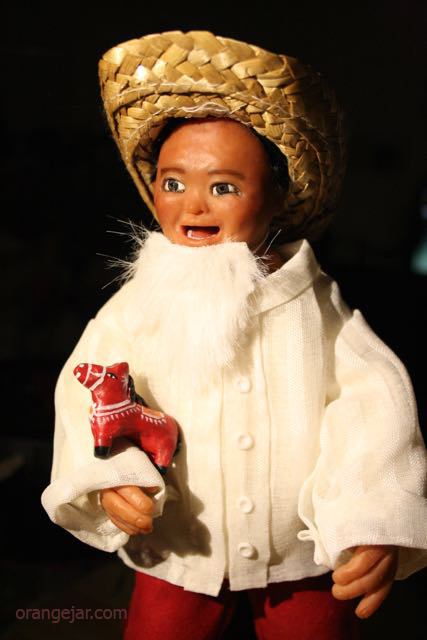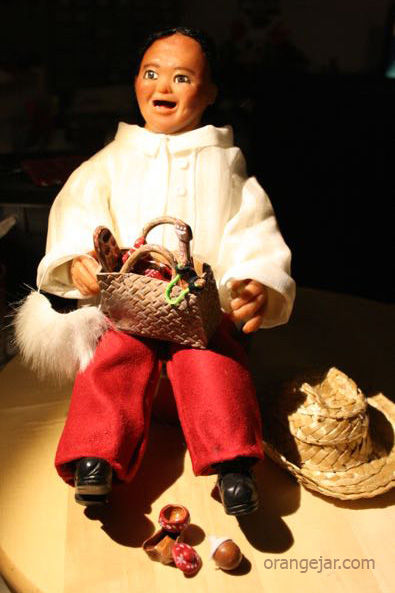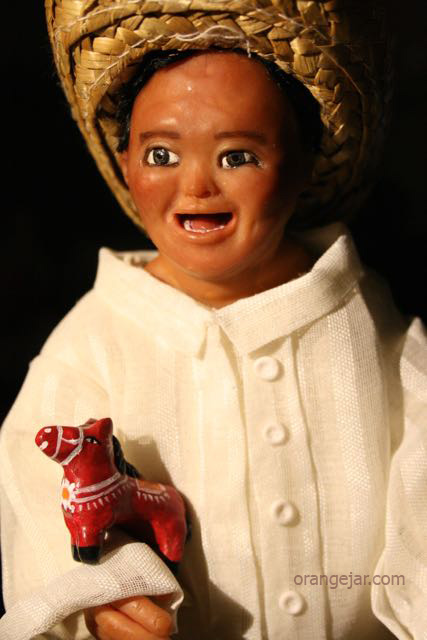Pinoy Santa

I had a lot of problems with this art doll – my first try to make a Filipino Santa. Santa is a winter person and the Philippines is a tropical country, so I needed to adapt and change a lot in his usual look.
But more basic than that were sculpting problems. This particular piece had a lot of moonies or those white, half-moons, that appear in the clay after curing. After a lot of research, I found that it can be caused by air trapped in the clay, moisture, over-conditioning and other possible causes.
It doesn't matter if you're painting over your work but with projects like this, when I'm using the polymer clay color as the actual skin, then it matters. Getting moonies is super annoying! I find that I get this more with Super Sculpey, but not so much in Super Sculpey Living Doll, Fimo Professional and Prosculpt.
Despite the moonies, I decided to continue on with costume and props, and here is all decked out and ready for Christmas! Since he is my interpretation of a Filipino Santa, I made him a traditional formal wear which is called a barong (or the closest to a barong I can make), over a canvas undershirt (I used an old white, cotton shirt) paired with a red, velvety Santa-like pants. I remember when we had to perform traditional Southern Tagalog dances in school, the male costume is a usually a white shirt and a pair of red pants, so I thought the barong with the red pants would look good on him. The velvety part is a nod to the season.
Of course Santa needs a bag with goodies, so I gave him a bayong which is a bag made with woven palm leaves. Nowadays, there are a lot of fashionable bags and handbags made with the same or similar materials in an updated style.



His goodies are traditional Philippine toys. First we have taka (paper mache) horse. These are usually colored bright red with black hair and decorated with colorful line drawings. I usually saw them during town fiestas, where vendors would line the streets with their wares. Imagine a section of the street filled with these gorgeous paper mache horses!
Next we have the tirado (slingshot), turumpo (spinning top), gitara (guitar - toy version), palayok (clay pots) and the sungka. The clay pot is also colored red with white designs on it like the taka horse. This is also typical of toy clay pots sold during Christmas and town festivals. You can buy them as miniatures! The pot is sitting on another clay creation, which acts as the stove. You put the coal directly under the pot. Even tough they were toys, they were made with real terracotta so we were able to use them with real coal and fire. I don't know the English translation for sungka so I'll describe how it is played.
Sungka is that long "board" sticking out of the bag like a loaf of bread. It is traditionally made with carved wood and sold with small shells. It is played by two players. The bigger grooves at the end of the board is assigned to a player and it acts as their "home base." Their home base is where they collect their "subi" (or take home). Whatever lands there is theirs when it's their turn to play. It acts as a counter of how many times they've gone around. There are six grooves on each side, not counting the home bases. At the start, each groove will have six shells.
Both players start playing at the same time. First, they choose one groove from their side of the board. Next, they scoop up the six shells in the groove and begin playing at the same time, depositing one shell on each groove, after the one they just emptied. One plays clockwise, the other one, counter.
Each player will drop one shell in their home base, skipping the competition's. When a player gets to the last shell, s/he drops it in the groove. If there are other shells in there, the player scoops all those up and continue playing. If the groove is empty, s/he drops the last shell and stops playing. The player now needs to wait till the other player loses a turn in the same way. The player with the most shells in his or her home base wins.
Ooh, I hope that description is accurate! It's been ages since I last played. Buying a sungka is in my to do list, but I want one that is beautifully carved with feet.
Wow, all these brought back very fond memories of childhood. I wish I could go back soon to celebrate a town fiesta or Christmas in the Philippines.




